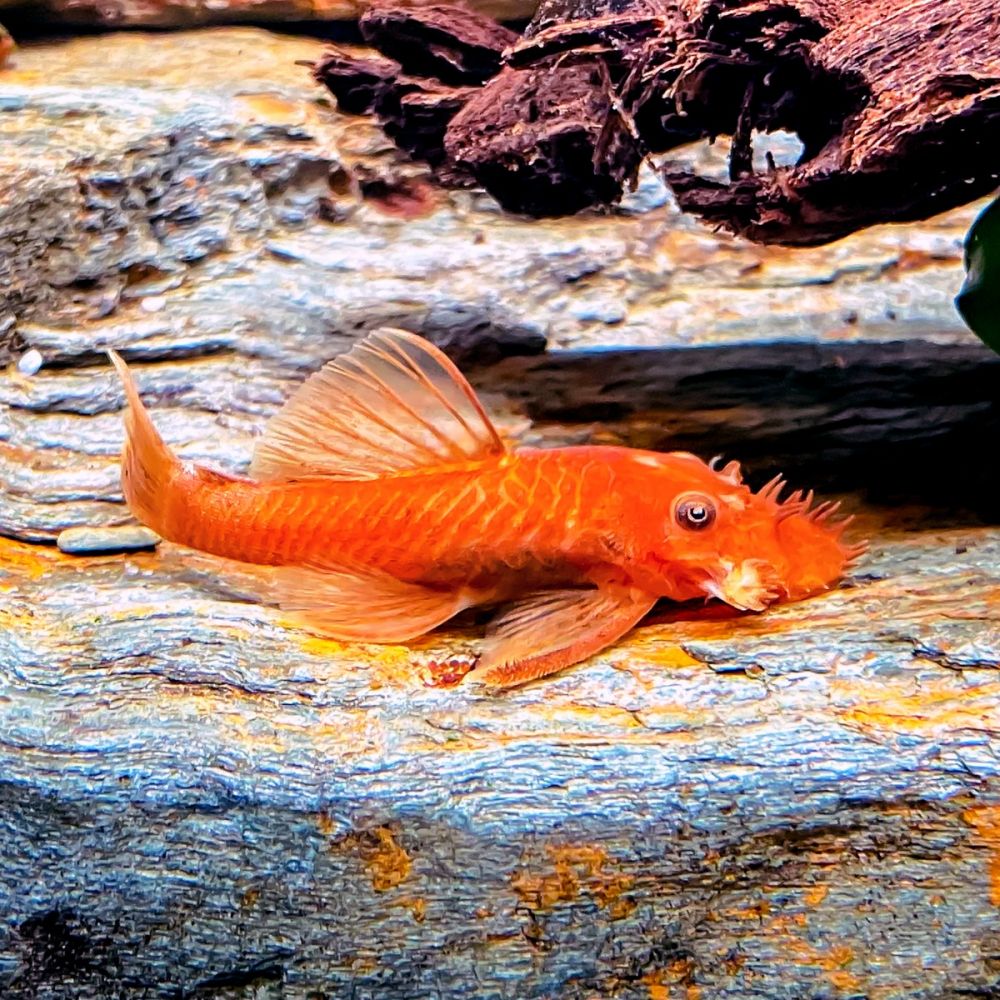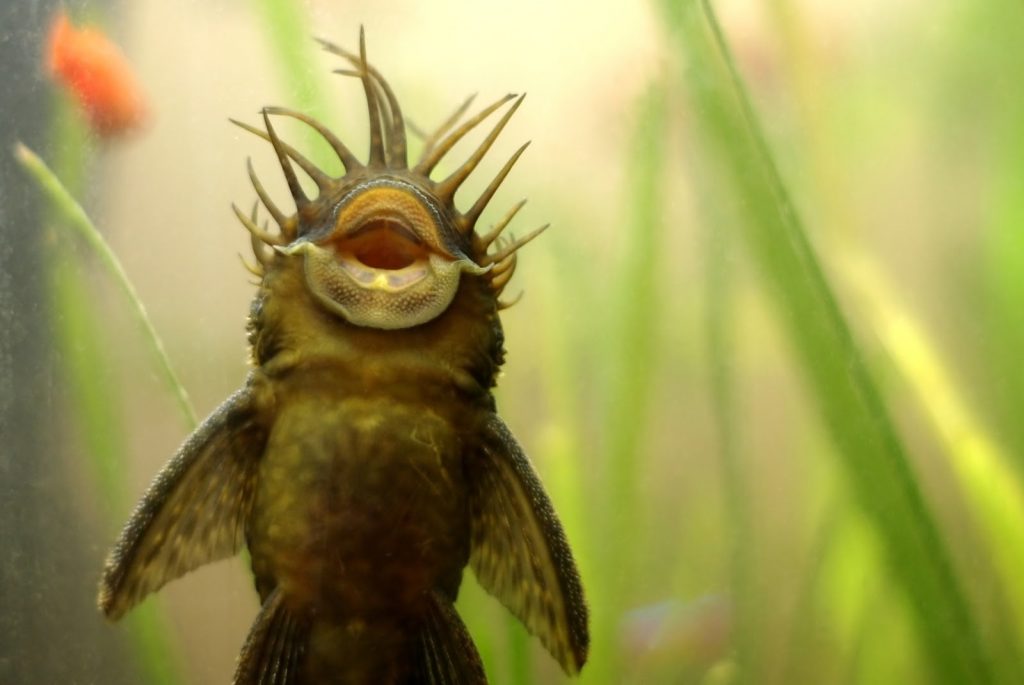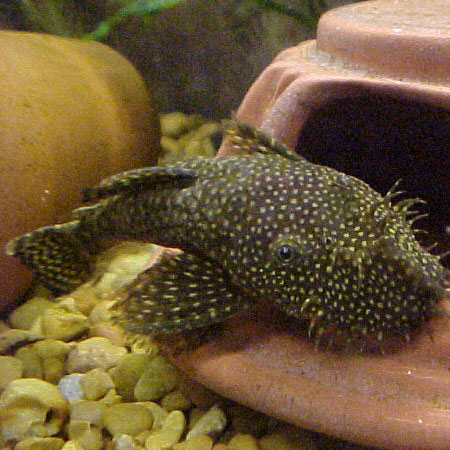Bristlenose Pleco
The Bristlenose Pleco, a member of the Ancistrus genus, is a deservedly popular resident in home aquariums across the United Kingdom. Hailing from the fast-flowing rivers and streams of the Amazon basin, this small and hardy catfish is renowned for its algae-eating prowess and generally peaceful nature. Unlike its common pleco cousin, which can grow to an unmanageable size, the Bristlenose remains a compact and fascinating addition to a wide range of community tanks. This guide provides a comprehensive overview of how to provide the best possible care for these charming, armoured catfish.
From Amazon to Aquarium: Natural Habitat
Understanding the Bristlenose Pleco’s natural environment is key to replicating a suitable habitat in your aquarium. They originate from well-oxygenated, often tannin-stained waters in South America, where they cling to submerged driftwood and hide amongst rocky crevices. This instinct for seeking shelter and rasping on wood is a fundamental aspect of their behaviour that must be catered for in captivity.
Appearance, Size, and Lifespan
The Bristlenose Pleco has a distinctive flattened body covered in bony plates, with an underslung sucker mouth perfect for grazing on surfaces. Their colour is typically a mottled brown or grey with lighter spots, providing excellent camouflage. Several captive-bred varieties are widely available in the UK, including albino, super red, and long-finned specimens.
One of their most defining features, and the source of their name, is the growth of fleshy tentacles, known as odontodes, on the snout. These are much more prominent on mature males. With proper care, a Bristlenose Pleco can live for 5 to 10 years, and sometimes even longer.
Setting Up the Perfect Bristlenose Home

Creating the right environment is the most crucial step in ensuring your pleco thrives.
Tank Size: A minimum tank size of 80 litres is recommended for a single adult Bristlenose Pleco. While they may be small when purchased, they require adequate space to establish a territory and to handle the bioload they produce.
Filtration: These are messy fish that produce a significant amount of waste. Therefore, a robust filtration system is essential. An external canister filter or a large internal filter with a good flow rate is ideal to maintain excellent water quality.
Water Flow: Accustomed to river currents, Bristlenose Plecos appreciate moderate water movement. This can be achieved by positioning the filter outlet to create a flow across the length of the tank. This also helps to keep the water well-oxygenated, which is vital for their health.
Substrate: To protect their delicate mouths and barbels, a soft substrate is paramount. Fine sand or small, smooth gravel is the best choice. Avoid sharp or coarse gravel which can cause injury and lead to infection.
Décor and Hiding Places: This is a non-negotiable aspect of their care.
- Driftwood: Every Bristlenose tank must contain at least one piece of bogwood or driftwood. They rasp on the wood to ingest lignin, a type of fibre that is essential for their digestion. It also provides a surface for beneficial biofilm to grow, which is a key food source.
- Caves: Being nocturnal and shy, they require secure hiding places to feel safe during the day. Purpose-built pleco caves, coconut shells, slate caves, or even terracotta pots on their side are all excellent options.
- Plants: Sturdy live plants such as Anubias, Java Fern, and Amazon Swords can provide additional cover and help to maintain water quality.
Ideal Water Parameters
Maintaining stable water conditions is crucial for the health of any fish. While Bristlenose Plecos are relatively hardy, they will flourish in a mature, fully cycled aquarium with the following parameters.
| Parameter | Ideal Range | Notes |
|---|---|---|
| Temperature | 23 – 27°C (73 – 81°F) | A standard aquarium heater is required. |
| pH | 6.5 – 7.5 | Stability is more important than a specific value. |
| Hardness (GH) | 5 – 15 dGH | Adaptable to most UK tap water. |
| Ammonia | 0 ppm | Toxic. The tank must be fully cycled. |
| Nitrite | 0 ppm | Toxic. The tank must be fully cycled. |
| Nitrate | < 20 ppm | Keep low with regular weekly water changes of 25-30%. |
Diet and Feeding

A common misconception is that Bristlenose Plecos can survive solely on the algae in your tank. This is incorrect and will lead to malnutrition. They are primarily herbivores and require a varied diet.
Feeding Schedule: Feed once a day, preferably in the evening just before or after the tank lights go out, as this is when they are most active.
A Balanced Bristlenose Diet
1. Staple Diet: Algae Wafers/Pellets (Approx. 60% of diet)
- What: These are the foundation of your pleco’s diet. Look for high-quality sinking wafers or pellets that are specifically formulated for herbivorous bottom-dwellers. They contain essential nutrients and spirulina algae.
- Frequency: Feed once daily, preferably in the evening when the pleco is most active. Only provide what it can consume within an hour or two.
2. Fresh Vegetables (Approx. 35% of diet)
- What: Fresh, blanched vegetables are vital for providing fibre, vitamins, and enrichment.
- Excellent choices include: Courgette (Zucchini), Cucumber, Sweet Potato, Bell Peppers, Spinach, and shelled Peas.
- How to Prepare: Lightly blanching the vegetables (dunking them in boiling water for a minute) helps them to soften and sink. You can use a pleco feeding clip or a stainless steel fork to hold them at the bottom of the tank.
- Frequency: Offer a slice of a vegetable 2-3 times per week instead of a wafer. Remember to remove any uneaten portions after 24 hours to prevent them from spoiling your water.
3. Occasional Protein Treat (Approx. 5% of diet)
- What: While mainly herbivores, they benefit from a small amount of protein. This mimics the grubs and crustaceans they would encounter in their natural habitat. Frozen foods are a safe and easy option.
- Good choices include: Bloodworm, Daphnia, or Brine Shrimp.
- Frequency: This is a treat and should be given sparingly. Offering a small amount once a week or once a fortnight is plenty.
The Non-Negotiable Extra: Driftwood
It is crucial to have at least one piece of bogwood or driftwood in the aquarium at all times. This is not just for decoration. Bristlenose Plecos rasp on the wood to consume lignin, a type of wood fibre that is essential for their digestion. A pleco without access to wood can suffer from digestive problems like bloat.
To prepare vegetables, blanch them lightly in boiling water for a minute to soften them, then weigh them down in the tank. Remove any uneaten portions after 24 hours to avoid fouling the water.
Behaviour and Suitable Tank Mates
Bristlenose Plecos are peaceful and make excellent additions to most community aquariums. They are bottom-dwellers and will generally ignore fish that occupy the middle and upper levels of the tank. Mature males can, however, become territorial towards other plecos or bottom-dwelling fish if there isn’t enough space or hiding spots.
Good Tank Mates:
- Tetras (Neon, Cardinal, Rummy-nose)
- Rasboras (Harlequin, Chilli)
- Livebearers (Guppies, Platies, Endler’s)
- Corydoras Catfish
- Dwarf Gouramis and other peaceful Anabantoids
Avoid:
- Large, aggressive Cichlids (e.g., Oscars, Jack Dempseys)
- Keeping two males together in a small tank.
Sexing and Breeding
Sexing mature Bristlenose Plecos is straightforward, making them one of the easier catfish to breed.
Male vs. Female Bristlenose Pleco
Distinguishing between male and female Bristlenose Plecos (Ancistrus sp.) is relatively straightforward once the fish begin to mature, which typically happens from around six months of age. For young, juvenile fish, it is nearly impossible to tell them apart.
The most definitive differences are in the bristles and body shape.
Primary Differences
| Feature | Male | Female |
|---|---|---|
| Bristles (Odontodes) | Develops large, prominent, and often branching bristles that grow all over the head and up the centre of the snout, resembling a thick beard. | Has no bristles at all, or will only develop a few small, fine bristles along the edge of the snout, similar to a moustache. |
| Body Shape | Generally has a more slender and streamlined body. | Tends to have a wider, rounder, and more robust body shape, which becomes particularly noticeable when she is carrying eggs. |
| Size | Can grow slightly larger and longer than females. | Is often a little shorter and stockier in build compared to a mature male. |
| Pectoral Fins | The leading ray of the pectoral fins (the fins just behind the gills) can be thicker and may develop small spikes. | The pectoral fins are typically smoother without noticeable spikes. |
Breeding: To encourage spawning, provide a conditioned pair (fed a rich, varied diet) with suitable caves. The male will select a cave, clean it meticulously, and entice a female inside. She will lay a clutch of bright orange, adhesive eggs, which the male then fertilises.
The male is an excellent father. He will guard the cave entrance and constantly fan the eggs with his fins to keep them clean and oxygenated. The eggs typically hatch in 4-10 days. The fry will initially feed on their yolk sacs before becoming free-swimming. They can then be fed on biofilm, crushed flakes, and commercially available fry foods.
Common Health Issues in the UK

With good care, Bristlenose Plecos are very robust. However, like any fish, they can be susceptible to health problems, often linked to stress or poor water quality.
| Disease | Symptoms | Common UK Treatment |
|---|---|---|
| White Spot (Ich) | Small white salt-like spots on the body and fins. Fish may ‘flick’ against objects. | Increase temperature slightly (to 28°C) and use a commercial white spot treatment such as eSHa EXIT or Waterlife Protozin. |
| Bacterial Infections | Red sores, ulcers, frayed fins (fin rot), lethargy. | Maintain pristine water quality. Use a broad-spectrum antibacterial treatment like eSHa 2000 or Waterlife Myxazin. |
| Fungal Infections | White, cotton-like growths on the body, fins, or mouth. | Often a secondary infection on an injury. Treat with an antifungal remedy such as eSHa 2000. |
| Bloat | Swollen, distended abdomen. | Often diet-related. Ensure access to driftwood and a high-fibre diet of vegetables. Fast the fish for a day or two. |
In conclusion, the Bristlenose Pleco is a truly rewarding fish to keep. By providing them with a spacious, well-filtered aquarium that mimics their natural environment, a varied and appropriate diet, and stable water conditions, you will be rewarded with a healthy, active, and fascinating resident for many years to come.


